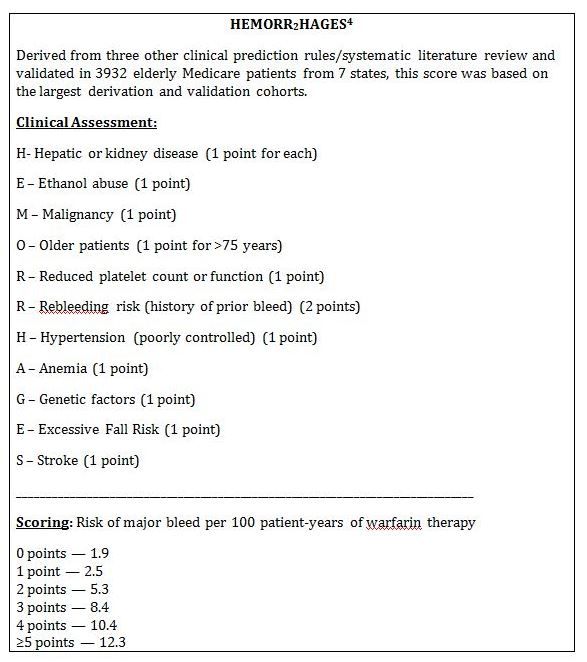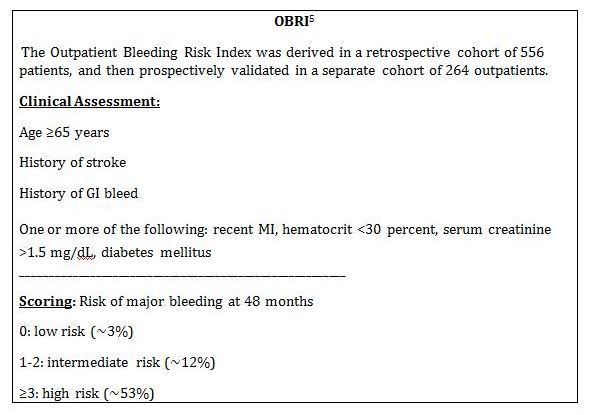Bleeding Risk in AF: Tools for Clinical Assessment
HAS-BLED, HEMORRHAGES, OBRI: Risk calculators to assess potential for bleeding in AF patients before anticoagulation.
Table 1. (Click to enlarge)

Table 2.

Table 3.

Anticoagulation options in atrial fibrillation (AF) have garnered significant attention in the past 5 years, with the introduction of novel oral factor Xa inhibitors and direct thrombin inhibitors emerging as alternatives to the traditional vitamin K antagonists. However, achieving the balance between risk of thromboembolism and bleeding remains a significant challenge.
Although the CHADS2 score is readily used to determine risk of thromboembolism in patients with AF, the risk assessment tools for bleeding, which are based on clinical factors, are less commonly incorporated into practice due to lack of familiarity with these calculators. Nevertheless, an assessment of bleeding risk should be conducted routinely for every patient before the decision is made to proceed with anticoagulation.
Based on multiple systematic reviews, the following factors have emerged as the strongest risk factors for developing a bleed while on warfarin:
• Older age (>75 years)
• Use of other anti-platelet drugs (such as aspirin, clopidogrel, prasugrel or non-steroidal anti-inflammatory agents)
• Uncontrolled hypertension
• History of previous bleeding episode
• Poorly controlled anticoagulation therapy
There are several bleeding risk indices that incorporate these risk factors and have been previously validated. The 3 examples that follow here-HAS-BLED (Table 1); HEMORR2HAGES (Table 2) and OBRI (Table 3) are most commonly used in clinical and research settings and can be most easily applied to an office-based practice.
As a cautionary note, these scores are derived from datasets in patients on vitamin K antagonists, and may not be accurate in those receiving the novel anti-coagulants. Furthermore, patients who have some of the significant risk factors for bleeding listed above are usually excluded from large atrial fibrillation trials and therefore, the efficacy results from these clinical trials may not confer the same net clinical benefit in this population. Finally, although these scores can be useful to identify high-risk individuals, it is noteworthy that no single bleeding risk index can provide a complete assessment of an individual’s bleeding risk.
References:
1. Lip GY, Frison L, Halperin JL, Lane DA. Comparative validation of a novel risk score for predicting bleeding risk in anticoagulated patients with atrial fibrillation: the Has-Bled (hypertension, abnormal renal/liver fucntion, storke, bleeding history or predisposition, labile INR, elderly, drugs/alcohol comcomitantly) score. J Am Coll Cardiol. 2011;57:173-180.
2. Cairns JA, Connolly S, McMurtry S, Stephenson M, Talajic M. Canadian Cardiovascular Society Atrial Fibrillation Guidelines 2010: prevention of stroke and systemic thromboembolism in atrial fibrillation and flutter. Can J Cardiol. 2011;27:74-90.
3. Camm AJ, Kirchhof P, Lip GY, et al. Guidelines for the management of atrial fibrillation: the Task Force for the Management of Atrial Fibrillation of the European Society of Cardiology (Esc). Eur Heart J. 2010;31:2369-2429.
4. Gage BF, Yan Y, Milligan PE, et al. Clinical classification schemes for predicting hemorrhage: results from the National Registry of Atrial Fibrillation (Nraf). Am Heart J. 2006;151:713-719.
5. Beyth RJ, Quinn LM, Landefeld CS. Prospective Evaluation of an index for predicting the risk of major bleeding in outpatients treated with warfarin. Am J Med. 1998;105:91-99.